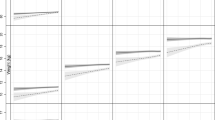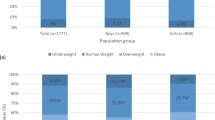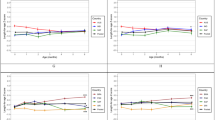Abstract
Background/objectives:
Low birth weight (LBW) and rapid postnatal weight gain are associated with future high body adiposity; however, the cumulative effect of LBW and postnatal weight gain remains unclear. The aim of this study was to investigate the influence of body proportionality of LBW infants and postnatal weight gain on body mass index (BMI) and waist circumference (WC) of 8-year-old children.
Subjects/methods:
A nested cross-sectional study was conducted in a cohort of children followed from birth to 6 months and reassessed at 8 years of age. The sample consisted of 167 children born at full term (67 with LBW and 100 with appropriate birth weight). Stunted LBW was defined as length <−2 z-score and wasted LBW as length ⩾ −2 z- score and Ponderal Index <2.5. Rapid growth was defined as weight gain greater than 0.67 s.d. score from birth to 6 months. Multivariate linear regression analysis was used to investigate the net effect of LBW and postnatal weight gain on BMI and WC, controlled for sex, total breastfeeding, socioeconomic status and maternal nutrition.
Results:
The stunted and wasted LBW contributed significantly to the reduction of BMI and WC, and together explained 10% of the variation of these measurements. Rapid weight gain in the first 6 months of life, shorter total breastfeeding duration, higher socioeconomic status and maternal BMI significantly explained the increase in child BMI and WC.
Conclusions:
It was concluded that LBW led to lower body measurements, whereas rapid postnatal weight gain determined higher BMI and WC among school age children.
This is a preview of subscription content, access via your institution
Access options
Subscribe to this journal
Receive 12 print issues and online access
$259.00 per year
only $21.58 per issue
Buy this article
- Purchase on Springer Link
- Instant access to full article PDF
Prices may be subject to local taxes which are calculated during checkout
Similar content being viewed by others
References
Meas T, Deghmoun S, Armoogum P, Alberti C, Levy-Marchal C . Consequences of being born small for gestational age on body composition: an 8-year follow-up study. J Clin Endocrinol Metab 2008; 93: 3804–3809.
Willing AL, Hanks LJ, Fernandez JR . Birth weight is associated with body composition in a multiethnic pediatric cohort. Open Obes J 2011; 1: 4–8.
Ong KKL, Ahmed ML, Emmett PM, Preece MA, Dunger DB . Association between postnatal catch-up growth and obesity in childhood: prospective cohort study. BMJ 2000; 320: 967–971.
Leunissen RW, Kerkhof GF, Stijnen T, Hokken-Koelega A . Timing and tempo of first-year rapid growth in relation to cardiovascular and metabolic risk profile in early adulthood. JAMA 2009; 301: 2234–2242.
Kramer MS, McLean FH, Olivier M, Willis DM, Usher RH . Body proportionality and head and length 'sparing' in growth-retarded neonates: a critical reappraisal. Pediatrics 1989; 84: 717–723.
Singhal A, Wells J, Cole TJ, Fewtrell M, Lucas A . Programming of lean body mass: a link between birth weight, obesity, and cardiovascular disease? Am J Clin Nutr 2003; 77: 726–730.
Botton J, Heude B, Maccario J, Ducimetière P, Charles MA FLVS Study Group. Postnatal weight and height growth velocities at different ages between birth and 5y and body composition in adolescent boys and girls. Am J Clin Nutr 2008; 87: 1760–1768.
Vaag A, Jensen CB, Poulsen P, Brøns C, Pilgaard K, Grunnet L et al. Metabolic aspects of insulin resistance in individuals born small for gestational age. Horm Res 2006; 65: 137–143.
Ozanne SE, Jensen CB, Tingey KJ, Storgaard H, Madsbad S, Vaag AA . Low birth weight is associated with specific changes in muscle insulin-signaling protein expression. Diabetologia 2005; 48: 547–552.
Onal EE, Cinaz P, Atalay Y, Türkyilmaz C, Bideci A, Aktürk A . Umbilical cord ghrelin concentrations in small- and appropriate-for-gestational age newborn infants: relationship to anthropometric markers. J Endocrinol 2004; 180: 267–271.
Jaquet D, Leger J, Tabone MD, Czernichow P, Levy-Marchal C . High serum leptin concentrations during catch-up growth of children born with intrauterine growth retardation. J Clin Endocrinol Metab 1999; 84: 1949–1953.
Kyriakakou M, Malamitsi-Puchner A, Militsi H, Boutsikou T, Margeli A, Hassiakos D et al. Leptin and adiponectin concentrations in intrauterine growth restricted and appropriate for gestational age fetuses, neonates, and their mothers. Eur J Endocrinol 2008; 158: 343–348.
Eickmann SH, Lima MC, Motta ME, Romani SAMLira PIC . Growth of full term low and adequate birth weight infants during the first two years of life. Rev Saúde Pública 2006; 40: 1073–1081.
Koletzko B, Kries R, Monasterolo RC, Escribano J, Scaglioni S, Giovannini M et al. Lower protein in infant formula is associated with lower weight up to age 2 y: a randomized clinical trial. Am J Clin Nutr 2009; 89: 1836–1845.
Karaolis-Danckert N, Buyken AE, Kulig M, Kroke A, Forster J . Kamin W et al. How pre and postnatal risk factors modify the effect of rapid weight gain in infancy and early childhood on subsequent fat mass development: results from the Multicenter Allergy Study. Am J Clin Nutr 2008; 87: 1356–1364.
Lira PIC, Ashworth A, Morris SS . Low birth weight and morbidity from diarrhoea and respiratory infection in northeast Brazil. J Pediatr 1996; 128: 497–504.
Capurro H, Konichezky S, Fonseca D, Caldeyro-Barcia R . A simplified method for diagnosis of gestational age in the newborn infant. J Pediatr 1978; 93: 120–122.
World Health Organization. Physical Status: The Use and Interpretation of Anthropometry. Report of WHO Expert Committee. Geneva: WHO, 1995.
World Health Organization. WHO AnthroPlus for personal computers Manual: Software for assessing growth of the world's children and adolescents. Geneva: WHO, 2009: (http://www.who.int/growthref/tools/en/).
Amorim RJM, Lima MC, Lira PIC, Emond AM . Does low birth weight influence the nutritional status at school age? A cohort study in northeast Brazil. Matern Child Nutr 2011; 7: 295–306.
Gibson RS.Body composition In Gibson RS (ed) Principals of Nutritional Assessment 2nd ed. Oxford University Press: Oxford, 2005, pp 282–284.
Hediger ML, Overpeck MD, Kuczmarski RJ, McGlynn A, Maurer KR, Davis WW . Muscularity and fatness of infants and young children born small-or-large-for-gestational-age. Pediatrics 1998; 102: 1–7.
Elia M, Betts P, Jackson DM, Mulligan J . Fetal programming of body dimensions and percentage body fat measured in prepubertal children with a 4-component model of body composition, dual-energy X-ray absorptiometry, deuterium dilution, densitometry, and skinfold thicknesses. Am J Clin Nutr 2007; 86: 618–624.
Al Riyamy N, Walker MG, Proctor LK . YoavYinon, Windrim RC, Kingdom JC. Utility of head/abdomen circumference ratio in the evolution of severe early-onset intrauterine growth restriction. J Obstet Gynaecol Can 2011; 33: 715–719.
Cameron N, Pettifor J, De Wet T, Norris S . The relation of rapid weight gain in infancy to obesity and skeletal maturity in childhood. Obes Res 2003; 11: 457–460.
Dulloo AG . Regulation of fat storage via suppressed thermogenesis: a thrifty phenotype that predisposes individuals with catch-up growth to insulin resistance and obesity. Horm Res 2006; 65 (Suppl 3): S90–S97.
Briana DD, Malamitsi-Puchner A . Intrauterine growth restriction and adult disease: the role of adipocytokines. Eur J Endocrinol 2009; 160: 337–347.
Solinas G, Summermatter S, Mainieri D, Gubler M, Pirola L, Wymann MP et al. The direct effect of leptin on skeletal muscle thermogenesis is mediated by substrate cycling between de novo lipogenesis and lipid oxidation. FEBS Letter 2004; 577: 539–544.
Berg AH, Combs TP . Scherer PE.ACRP30/adiponectin: an adipokine regulating glucose and lipid metabolism. Trends Endocrinol Metab 2002; 13: 84–89.
Chomtho S, Wells JCK, Williams JE, Davies PS, Lucas A, Fewtrell MS . Infant growth and later body composition: evidence from the 4-component model. Am J Clin Nutr 2008; 87: 1776–1784.
Druet C, Stettler N, Sharp S, Simmons RK, Cooper C, Smith GD et al. Prediction of childhood obesity by infancy weight gain: an individual-level meta-analysis. Paediat Perin Epidemiol 2012; 26: 19–26.
Ekelund U, Ong K, Linne Y, Neovius M, Brage S, Dunger DB et al. Upward weight percentile crossing in infancy and early childhood independently predicts fat mass in young adults: the Stockholm Weight Development Study (SWEDES). Am J Clin Nutr 2006; 83: 324–330.
Hui LL, Schooling CM, Leung SS, Mak KH, Ho LM, Lam TH et al. Birth weight, infant growth, and childhood body mass index Hong Kong’s children of 1997 Birth Cohort. Arch Pediat Adolesc Med 2008; 162: 212–218.
Barker DJ, Eriksson JG, Forsén T, Osmond C . Fetal origins of adult disease: strength of effects and biological basis. Int J Epidemiol 2002; 31: 1235–1239.
Oliveira VA, Assis AMO, Pinheiro SMC, Barreto ML . Determinants of weight and linear growth deficits in children under two years of age. Rev Saúde Pública 2006; 40: 874–882.
Lima MC, Dantas HF, Amorim RJM . Lira PIC.Does fetal growth restriction influence body composition at school age? J Pediatr (Rio J) 2011; 87: 29–35.
Coutinho SB, Lima MC, Ashworth A, Lira PIC. The impact of training based on the Baby-Friendly Hospital Initiative on breastfeeding practices in the Northeast of Brazil. J Pediatr (Rio J) 2005; 81: 471–477.
Ong KK, Emmett PM, Noble S, Ness A, Dunger DB . ALSPAC Study Team. Dietary energy intake at the age of 4 months predicts postnatal weight gain and childhood body mass index. Pediatrics 2006; 117: E503–E508.
Stettler N, Stallings VA, Troxel AB, Zhao J, Schinnar R, Nelson SE . Weight gain in the first week of life and overweight in adulthood: A cohort study of European American subjects fed infant formula. Circulation 2005; 111: 1897–1903.
Heinig MJ, Nommsen LA, Peerson JM, Lonnerdal B, Dewey KG . Energy and protein intakes of breast-fed and formula-fed infants during the first year of life and their association with growth velocity: the Darling Study. Am J Clin Nutr 1993; 58: 152–161.
Stettler N, Zemel BS, Kumanyika S, Virginia AS . Infant weight gain and childhood overweight status in a Multicenter, Cohort study. Pediatrics 2002; 109: 194–199.
Acknowledgements
We express our thanks to Fundação Nacional de Saúde, field workers, mothers and children for their cooperation, Wellcome Trust-UK and CNPq (Conselho Nacional de Desenvolvimento Científico e Tecnológico) for research support and grant for Pedro Lira, Marilia Lima, and CAPES (Coordenação de Aperfeiçoamento de Pessoal de Nível Superior) for Fabiana Gonçalves. The Wellcome Trust, UK (grant 064220Z/01Z) and CNPq, Brazil (grant 476891/2001-9).
AUTHOR CONTRIBUTIONS
FCLSPG, RJMA, PICL and MCL conceived and designed the study and analyzed and interpreted the data; RJMA and PICL supervised the data collection; FCLSPG and SHE drafted the manuscript; and RJMA, SHE and MCL provided advice and a critical revision of the manuscript.
Author information
Authors and Affiliations
Corresponding author
Ethics declarations
Competing interests
The authors declare no conflict of interest.
Rights and permissions
About this article
Cite this article
Gonçalves, F., Amorim, R., Eickmann, S. et al. The influence of low birth weight body proportionality and postnatal weight gain on anthropometric measures of 8-year-old children: a cohort study in Northeast Brazil. Eur J Clin Nutr 68, 876–881 (2014). https://doi.org/10.1038/ejcn.2014.68
Received:
Revised:
Accepted:
Published:
Issue Date:
DOI: https://doi.org/10.1038/ejcn.2014.68
This article is cited by
-
Weight Gain from Birth to Adolescence and TyG Index at Age 18 Years: A Cohort Study in Northeast Brazil
Maternal and Child Health Journal (2024)
-
Timing of rapid weight gain and its effect on subsequent overweight or obesity in childhood: findings from a longitudinal birth cohort study
BMC Pediatrics (2020)
-
Nutrition- and feeding practice-related risk factors for rapid weight gain during the first year of life: a population-based birth cohort study
BMC Pediatrics (2020)
-
Relationship between prenatal growth, postnatal growth and childhood obesity: a review
European Journal of Clinical Nutrition (2017)
-
Relationship of maternal birth weight on maternal and neonatal outcomes: a multicenter study in Beijing
Journal of Perinatology (2016)



